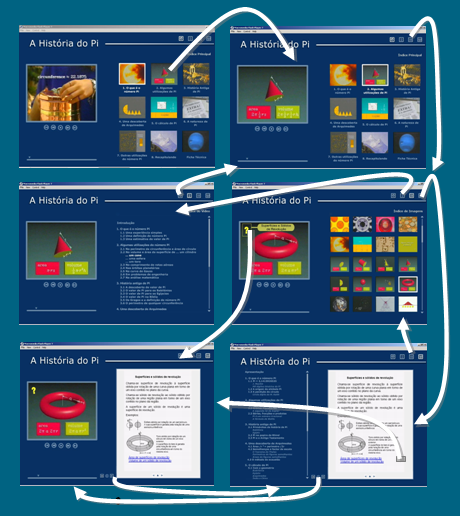Visualization has always
been an essential aid in the communication of mathematics. It is an
important way to concretize concepts, to develop abstraction skills, and to
motivate learning, for example in topology and geometry, and in the
application of numerical methods to simulations of the real world.
Video has proven to be one
of the most adequate ways to communicate visualization results, allowing to
present in a rich cultural context a large quantity and diversity of
information in a brief period of time. However, by itself, video has a
limited capability to support learning. The structure and interaction
introduced by hypervideo allow providing the user with greater control and
autonomy, exploring links among the information conveyed by the video and
complemented by other materials, augmenting its capabilities as a cognitive
artifact.
The Story of Pi video
discusses the early history of Pi and shows how it appears in a variety of
formulas and applications, many of which have nothing to do with circles,
namely in probability problems. It is part of a series of modules, developed
under Project Mathematics! [20], to introduce basic mathematical concepts in
high school or community college, using live action, music, special effects,
and imaginative computer animation that bring mathematics to life.

Figure 1: Sequence of early
attempts to estimate the value of Pi.

Figure 2: Animated derivations
of the formula for the area of a circle.
The hypervideo developed
for The Story of Pi structures and integrates the video with other materials,
augmenting their individual affordances to support learning. Video can be
navigated from different types of indexes that are presented in synchrony with
the video. The textbook was converted into hypertext, respecting its underlying
hierarchical structure, and further enriched with links involving text, images,
video, and applications, allowing to capture relations among them and to
illustrate or complement the information conveyed by each one. Some features of
the hypervideo are presented in the following examples.

Figure 3: Navigation in the
hypervideo: video indexes and integration of video and textbook.
By Tom M. Apostol, Teresa Chambel, Suzana NŠpoles,
Josť Francisco Rodrigues, and Lara Santos
The Story of Pi in hypervideo is described
in this paper (pdf)
and demo (pdf),
and published as an interactive CD.
Other publications
Selection of Related Work:
Bentley, P., and D. Come. An Introduction to
Creative Evolutionary Systems. In Bentley, P., and Corne, D (eds.) Creative
Evolutionary Systems. Morgan Kaufmann, 2002.
Apostol, T., 1989. Project MATHEMATICS!- The Story
of π – Program Guide and Workbook, CalTech, California Institute of Technology,
Pasadena, CA 91125, USA.
Apostol, T., Blinn, J., 1993. Using Computer
Animation to Teach Mathematics, CBMS Issues in Mathematics Education, V.3.
13-38.
Liestōl, G., 1994. Aesthetic and Rhetorical
Aspects of Linking Video in Hypermedia. In Proceedings of ACM Hypertext’94.
Edinburgh, UK, pp. 217-223.
Norman, D., 1993. Things That Make Us Smart.
Addison Wesley Publishing Company.
Other Tc Projects

